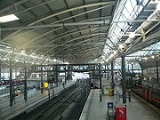
Leeds City railway station
Encyclopedia
Leeds railway station is the mainline railway station serving the city centre
of Leeds
in West Yorkshire
, England
. The station provides connections to London
, Bristol
, Plymouth
and the South West, Nottingham
, Birmingham
and the Midlands
, Newcastle upon Tyne
, York
, Edinburgh
and the North East
, Manchester
and Liverpool
and the North West
, Hull
, Scarborough, Selby
and Doncaster
, as well as to local and regional destinations in Yorkshire
. It is also the terminus for trains running on the scenic Settle to Carlisle line
, as well as the hub of the Metro commuter network
. It is located on New Station Street to the south of City Square
, at the bottom of Park Row, behind the landmark Queens Hotel
.
In 2008/9, Leeds was the busiest railway station in the North of England and the third busiest in the United Kingdom outside London, after Birmingham New Street and Glasgow Central
. According to Network Rail
, which manages the station, over 36.8 million people use the station annually.
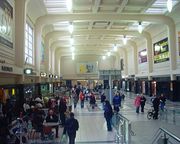
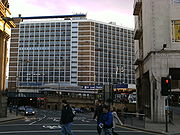 The station is situated on a hill falling from the south of the city down to the River Aire
The station is situated on a hill falling from the south of the city down to the River Aire
and the Leeds canal basin. Much of it is supported on a huge number of Victorian
brick vaulted arches known to the people of Leeds as The Dark Arches
. Situated just off Neville Street under the Dark Arches is Granary Wharf; a shopping centre consisting of cafes, restaurants, shops and exhibition spaces nestling in the arches directly beneath the railway station.
The station itself has 17 platforms, making it the largest (by number of platforms) in England outside London. There are ten terminus platforms and seven through platforms. Retail facilities within the closed (gated) part of the station include Starbucks
and Upper Crust
, while there is a much wider retail offering on the North and South Concourses. This includes names such as Wetherspoons
, Burger King
, McDonalds, two branches of WH Smith, Boots, Upper Crust
and a Marks & Spencer
Simply Food store. A British Transport Police
station is situated on New Station Street, housing officers who police the West Yorkshire
railway stations.
Leeds station is of note in that it retained manned ticket barriers through the 1990s until 2008, when they were replaced by automatic barriers by Northern Rail
to help improve the congestion around the barriers ar peak times. During this time barriers were removed from almost every British Rail station, although automatic barriers have now returned to many stations, particularly in London, the South and South Wales. Liverpool Lime Street
was another station that retained manned barriers; both stations are characterised by a mix of suburban and long-distance services.
Platform usage varies depending on operational circumstances but is generally:
Further bus stops are located on Neville Street below the station, as well as around City Square outside the station. Infirmary Street and Boar Lane Bus Points are a short walk for more bus connections.
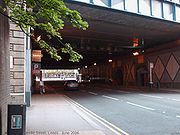

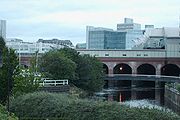 The railways first came to Leeds in 1834, when the Leeds and Selby Railway
The railways first came to Leeds in 1834, when the Leeds and Selby Railway
(which became part of the North Eastern Railway
) opened its line. This had a terminus at Marsh Lane
, to the east of the city centre. In 1840, the North Midland Railway
(one of the original constituents of the Midland Railway
) constructed its line from Derby
via Rotherham
to a terminus at Hunslet Lane
, to the south. This was extended to a more centrally-located terminus at Wellington Street in 1846, known as Wellington Station.
Another station, Leeds Central (also situated on Wellington Street), was opened in 1854 by the Manchester and Leeds Railway
and the London and North Western Railway
, or LNWR. This station was eventually owned jointly by the LNWR and the North Eastern Railway, but other companies also had powers to run trains there, including the Great Northern Railway
and the Lancashire and Yorkshire Railway
.
In 1869 a station called New Station opened as a joint enterprise by the LNWR and the North Eastern Railway. This connected the former Leeds and Selby Railway line to the east with the LNWR lines to the west. A mile-long connection was built, carried entirely on viaducts and bridges. New Station itself was built partially on a bridge over the River Aire. It was situated adjacent to Wellington station.
The map to the right shows the variety of different railway lines in Leeds in 1913.
Following the 1921 Railways Act
, when railways in Great Britain were grouped into four companies, New Station remained jointly-operated, but now by the London, Midland and Scottish Railway
(LMS) and the London and North Eastern Railway
(LNER).
John Poulson
, (who also designed Leeds International Swimming Pool as well as many other railway stations). This provided British Railways with administrative buildings. In recent years the buildings have become dated and hard to let. The buildings are currently unoccupied, and are expected to be refurbished in 2009 and let as offices. The building was famously lambasted by poet, John Betjeman
in 1967, stating they blocked all of the light out of City Square
, and the building was just a testament to money with no architectural merit.
, the construction of a new concourse and an overall roof. At the time of this rebuilding, the station was served by 500 trains on a typical day, with 2.75 million passenger journeys a year.

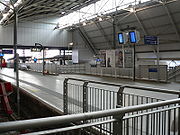
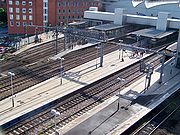 By the 1990s, the station's capacity was exceeded on a daily basis, and the 1967 design was deemed inadequate. Between 1999 and 2002, a major rebuilding project took place, branded as Leeds 1st. This project saw the construction of additional approach tracks at the western end of the station, improving efficiency by separating trains travelling to or from different destinations and preventing them from having to cross each other's routes. The station was expanded from 12 to 17 platforms, with the construction of new platforms on the south side, and reopening of the now-disused parcels depot to passengers on the north side. The majority of the track, points and signals were also replaced. The most visible change to passengers, however, was the replacement of the 1967 metal canopy with a new glass roof, considerably increasing the amount of daylight on the platforms. A new footbridge was also provided, replacing the previous underpass. Ancillary improvements include a new multi-storey car park and station entrance, refurbishing the North Concourse and expanding retail facilities.
By the 1990s, the station's capacity was exceeded on a daily basis, and the 1967 design was deemed inadequate. Between 1999 and 2002, a major rebuilding project took place, branded as Leeds 1st. This project saw the construction of additional approach tracks at the western end of the station, improving efficiency by separating trains travelling to or from different destinations and preventing them from having to cross each other's routes. The station was expanded from 12 to 17 platforms, with the construction of new platforms on the south side, and reopening of the now-disused parcels depot to passengers on the north side. The majority of the track, points and signals were also replaced. The most visible change to passengers, however, was the replacement of the 1967 metal canopy with a new glass roof, considerably increasing the amount of daylight on the platforms. A new footbridge was also provided, replacing the previous underpass. Ancillary improvements include a new multi-storey car park and station entrance, refurbishing the North Concourse and expanding retail facilities.
A small temporary station called Leeds Whitehall
was provided to handle some services while the station was being remodelled. This has now been demolished.
, CrossCountry
, TransPennine Express, Northern Rail
and East Midlands Trains
. It is also the hub of the MetroTrain network in West Yorkshire
, being the terminus of the following lines:
Leeds City Centre
Leeds city centre is the central business district of Leeds, England. It is within the Leeds Central parliamentary constituency, represented by Hilary Benn as MP since a by-election in 1999...
of Leeds
Leeds
Leeds is a city and metropolitan borough in West Yorkshire, England. In 2001 Leeds' main urban subdivision had a population of 443,247, while the entire city has a population of 798,800 , making it the 30th-most populous city in the European Union.Leeds is the cultural, financial and commercial...
in West Yorkshire
West Yorkshire
West Yorkshire is a metropolitan county within the Yorkshire and the Humber region of England with a population of 2.2 million. West Yorkshire came into existence as a metropolitan county in 1974 after the passage of the Local Government Act 1972....
, England
England
England is a country that is part of the United Kingdom. It shares land borders with Scotland to the north and Wales to the west; the Irish Sea is to the north west, the Celtic Sea to the south west, with the North Sea to the east and the English Channel to the south separating it from continental...
. The station provides connections to London
London
London is the capital city of :England and the :United Kingdom, the largest metropolitan area in the United Kingdom, and the largest urban zone in the European Union by most measures. Located on the River Thames, London has been a major settlement for two millennia, its history going back to its...
, Bristol
Bristol
Bristol is a city, unitary authority area and ceremonial county in South West England, with an estimated population of 433,100 for the unitary authority in 2009, and a surrounding Larger Urban Zone with an estimated 1,070,000 residents in 2007...
, Plymouth
Plymouth
Plymouth is a city and unitary authority area on the coast of Devon, England, about south-west of London. It is built between the mouths of the rivers Plym to the east and Tamar to the west, where they join Plymouth Sound...
and the South West, Nottingham
Nottingham
Nottingham is a city and unitary authority in the East Midlands of England. It is located in the ceremonial county of Nottinghamshire and represents one of eight members of the English Core Cities Group...
, Birmingham
Birmingham
Birmingham is a city and metropolitan borough in the West Midlands of England. It is the most populous British city outside the capital London, with a population of 1,036,900 , and lies at the heart of the West Midlands conurbation, the second most populous urban area in the United Kingdom with a...
and the Midlands
English Midlands
The Midlands, or the English Midlands, is the traditional name for the area comprising central England that broadly corresponds to the early medieval Kingdom of Mercia. It borders Southern England, Northern England, East Anglia and Wales. Its largest city is Birmingham, and it was an important...
, Newcastle upon Tyne
Newcastle upon Tyne
Newcastle upon Tyne is a city and metropolitan borough of Tyne and Wear, in North East England. Historically a part of Northumberland, it is situated on the north bank of the River Tyne...
, York
York
York is a walled city, situated at the confluence of the Rivers Ouse and Foss in North Yorkshire, England. The city has a rich heritage and has provided the backdrop to major political events throughout much of its two millennia of existence...
, Edinburgh
Edinburgh
Edinburgh is the capital city of Scotland, the second largest city in Scotland, and the eighth most populous in the United Kingdom. The City of Edinburgh Council governs one of Scotland's 32 local government council areas. The council area includes urban Edinburgh and a rural area...
and the North East
North East England
North East England is one of the nine official regions of England. It covers Northumberland, County Durham, Tyne and Wear, and Teesside . The only cities in the region are Durham, Newcastle upon Tyne and Sunderland...
, Manchester
Manchester
Manchester is a city and metropolitan borough in Greater Manchester, England. According to the Office for National Statistics, the 2010 mid-year population estimate for Manchester was 498,800. Manchester lies within one of the UK's largest metropolitan areas, the metropolitan county of Greater...
and Liverpool
Liverpool
Liverpool is a city and metropolitan borough of Merseyside, England, along the eastern side of the Mersey Estuary. It was founded as a borough in 1207 and was granted city status in 1880...
and the North West
North West England
North West England, informally known as The North West, is one of the nine official regions of England.North West England had a 2006 estimated population of 6,853,201 the third most populated region after London and the South East...
, Hull
Kingston upon Hull
Kingston upon Hull , usually referred to as Hull, is a city and unitary authority area in the ceremonial county of the East Riding of Yorkshire, England. It stands on the River Hull at its junction with the Humber estuary, 25 miles inland from the North Sea. Hull has a resident population of...
, Scarborough, Selby
Selby
Selby is a town and civil parish in North Yorkshire, England. Situated south of the city of York, along the course of the River Ouse, Selby is the largest and, with a population of 13,012, most populous settlement of the wider Selby local government district.Historically a part of the West Riding...
and Doncaster
Doncaster
Doncaster is a town in South Yorkshire, England, and the principal settlement of the Metropolitan Borough of Doncaster. The town is about from Sheffield and is popularly referred to as "Donny"...
, as well as to local and regional destinations in Yorkshire
Yorkshire
Yorkshire is a historic county of northern England and the largest in the United Kingdom. Because of its great size in comparison to other English counties, functions have been increasingly undertaken over time by its subdivisions, which have also been subject to periodic reform...
. It is also the terminus for trains running on the scenic Settle to Carlisle line
Settle-Carlisle Railway
The Settle–Carlisle Line is a long main railway line in northern England. It is also known as the Settle and Carlisle. It is a part of the National Rail network and was constructed in the 1870s...
, as well as the hub of the Metro commuter network
Commuter rail in the United Kingdom
Urban rail, commuter rail, regional rail, or suburban rail, plays a key role in the public transport system of many of the United Kingdom's major cities. Urban rail is defined as a rail service between a central business district and suburbs or other locations that draw large numbers of people on a...
. It is located on New Station Street to the south of City Square
Leeds City Square
City Square is a paved open area in Leeds city centre in West Yorkshire, England.In 1897, the Leeds city council of the time wanted to improve the open space near to the Post Office and in 1899 work was completed. The city square was enhanced with the erection of statues, the grandest being the...
, at the bottom of Park Row, behind the landmark Queens Hotel
Queens Hotel (Leeds)
Queens Hotel is a hotel owned by Quintessential Hotels, located on Leeds City Square in Leeds, West Yorkshire, England.It is an elegant Art Deco Grade II listed building. It was constructed in 1937 by architects W.Curtis Green and W.H. Hamlyn for the London, Midland and Scottish Railway...
.
In 2008/9, Leeds was the busiest railway station in the North of England and the third busiest in the United Kingdom outside London, after Birmingham New Street and Glasgow Central
Glasgow Central station
Glasgow Central is the larger of the two present main-line railway terminals in Glasgow, the largest city in Scotland. The station was opened by the Caledonian Railway on 31 July 1879 and is currently managed by Network Rail...
. According to Network Rail
Network Rail
Network Rail is the government-created owner and operator of most of the rail infrastructure in Great Britain .; it is not responsible for railway infrastructure in Northern Ireland...
, which manages the station, over 36.8 million people use the station annually.
Description


River Aire
The River Aire is a major river in Yorkshire, England of length . Part of the river is canalised, and is known as the Aire and Calder Navigation....
and the Leeds canal basin. Much of it is supported on a huge number of Victorian
Victorian architecture
The term Victorian architecture refers collectively to several architectural styles employed predominantly during the middle and late 19th century. The period that it indicates may slightly overlap the actual reign, 20 June 1837 – 22 January 1901, of Queen Victoria. This represents the British and...
brick vaulted arches known to the people of Leeds as The Dark Arches
The Dark Arches
Granary Wharf is a shopping centre built in the brick tunnels underneath Leeds railway station and above the River Aire on Dark Neville Street in Leeds, West Yorkshire, England. The tunnel complex is known locally as the Dark Arches.-History:...
. Situated just off Neville Street under the Dark Arches is Granary Wharf; a shopping centre consisting of cafes, restaurants, shops and exhibition spaces nestling in the arches directly beneath the railway station.
The station itself has 17 platforms, making it the largest (by number of platforms) in England outside London. There are ten terminus platforms and seven through platforms. Retail facilities within the closed (gated) part of the station include Starbucks
Starbucks
Starbucks Corporation is an international coffee and coffeehouse chain based in Seattle, Washington. Starbucks is the largest coffeehouse company in the world, with 17,009 stores in 55 countries, including over 11,000 in the United States, over 1,000 in Canada, over 700 in the United Kingdom, and...
and Upper Crust
Upper Crust
Upper Crust is an international chain of baguette restaurants concentrated along commuter routes, their outlets are commonplace in stations and terminals. Branches are also present in some Universities in the UK, including City University, London. There are also branches at the central railway...
, while there is a much wider retail offering on the North and South Concourses. This includes names such as Wetherspoons
Wetherspoons
J D Wetherspoon plc is a British pub chain based in Watford. Founded as a single pub in 1979 by Tim Martin, the company now owns 815 outlets. The chain champions cask ale, low prices, long opening hours, and no music. The company also operates the Lloyds No...
, Burger King
Burger King
Burger King, often abbreviated as BK, is a global chain of hamburger fast food restaurants headquartered in unincorporated Miami-Dade County, Florida, United States. The company began in 1953 as Insta-Burger King, a Jacksonville, Florida-based restaurant chain...
, McDonalds, two branches of WH Smith, Boots, Upper Crust
Upper Crust
Upper Crust is an international chain of baguette restaurants concentrated along commuter routes, their outlets are commonplace in stations and terminals. Branches are also present in some Universities in the UK, including City University, London. There are also branches at the central railway...
and a Marks & Spencer
Marks & Spencer
Marks and Spencer plc is a British retailer headquartered in the City of Westminster, London, with over 700 stores in the United Kingdom and over 300 stores spread across more than 40 countries. It specialises in the selling of clothing and luxury food products...
Simply Food store. A British Transport Police
British Transport Police
The British Transport Police is a special police force that polices those railways and light-rail systems in Great Britain for which it has entered into an agreement to provide such services...
station is situated on New Station Street, housing officers who police the West Yorkshire
West Yorkshire
West Yorkshire is a metropolitan county within the Yorkshire and the Humber region of England with a population of 2.2 million. West Yorkshire came into existence as a metropolitan county in 1974 after the passage of the Local Government Act 1972....
railway stations.
Leeds station is of note in that it retained manned ticket barriers through the 1990s until 2008, when they were replaced by automatic barriers by Northern Rail
Northern Rail
Northern Rail is a British train operating company that has operated local passenger services in Northern England since 2004. Northern Rail's owner, Serco-Abellio, is a consortium formed of Abellio and Serco, an international operator of public transport systems...
to help improve the congestion around the barriers ar peak times. During this time barriers were removed from almost every British Rail station, although automatic barriers have now returned to many stations, particularly in London, the South and South Wales. Liverpool Lime Street
Liverpool Lime Street railway station
Liverpool Lime Street is a railway station serving the city centre of Liverpool, England. The station lies on a branch of the West Coast Main Line from London Euston, and on the Wirral Line of the Merseyrail network...
was another station that retained manned barriers; both stations are characterised by a mix of suburban and long-distance services.
Platform usage varies depending on operational circumstances but is generally:
- 1–6 – BaysBay platformBay platform is a railway-related term commonly used in the UK and Australia to describe a dead-end platform at a railway station that has through lines...
mostly used by MetroTrain services operated by Northern RailNorthern RailNorthern Rail is a British train operating company that has operated local passenger services in Northern England since 2004. Northern Rail's owner, Serco-Abellio, is a consortium formed of Abellio and Serco, an international operator of public transport systems...
, although some East CoastEast Coast (train operating company)East Coast is a British train operating company running high-speed passenger services on the East Coast Main Line between London, Yorkshire, the North East and Scotland...
(EC) and other Northern services start and finish there. EC services between Skipton or Bradford Forster Square and London often reverse at these platforms. - 8, 9, 11, 12, 15, 16 – through platforms. In general, EC services that don't terminate or reverse at Platform 6 use Platform 8. CrossCountry services heading North to York and beyond tend to depart from Platform 9 or 11; those heading South often use 12. Platforms 15 and 16 tend to be used by North/East and South/Westbound Transpennine Express services to Newcastle and York, and Huddersfield, Manchester Airport and Liverpool Lime Street respectively.
- 7, 14 – Bays generally used for local Northern services running North/East from Leeds.
- 10, 13, 17 – Bays generally used for local and regional Northern services running South/West to Sheffield and Nottingham.
Transport links
Leeds Interchange, located at the New Station Street exit, provides onward transport connections from the station. There are five bus stands serving Arriva, Centrebus and First routes 4, 5, 16, 16A, 19, 19A, 40, 40A, 85, 87, 90, 95, 757, 870 and DalesBus services. A 24 hour taxi rank also operates at the interchange.Further bus stops are located on Neville Street below the station, as well as around City Square outside the station. Infirmary Street and Boar Lane Bus Points are a short walk for more bus connections.
Cycle hub
Leeds Interchange hosts one of the UK's first cycle hubs that allows a number of cycling services including repair, storage and rental. The facility opened in Summer 2010 and is designed to encourage visitors and commuters into Leeds to continue their journey from the station by bike. Its design is based on the Dutch cyclepoint concept.Past railway stations



Leeds and Selby Railway
The Leeds and Selby Railway was an early British railway company and first mainline railway in Yorkshire. It was opened in 1834.The company was absorbed by the York and North Midland Railway and the line remained in use through the subsequent NER, LNER, BR and post-privatisation periods.As of 2010...
(which became part of the North Eastern Railway
North Eastern Railway (UK)
The North Eastern Railway , was an English railway company. It was incorporated in 1854, when four existing companies were combined, and was absorbed into the London and North Eastern Railway at the Grouping in 1923...
) opened its line. This had a terminus at Marsh Lane
Leeds Marsh Lane railway station
Marsh Lane railway station was a railway station that operated to the east of central Leeds, England, from 22 September 1834 to 1958.It had served as the terminus for the Leeds and Selby Railway services between Leeds and Selby and was the first main line to be built in Yorkshire and one of the...
, to the east of the city centre. In 1840, the North Midland Railway
North Midland Railway
The North Midland Railway was a British railway company, which opened its line from Derby to Rotherham and Leeds in 1840.At Derby it connected with the Birmingham and Derby Junction Railway and the Midland Counties Railway at what became known as the Tri Junct Station...
(one of the original constituents of the Midland Railway
Midland Railway
The Midland Railway was a railway company in the United Kingdom from 1844 to 1922, when it became part of the London, Midland and Scottish Railway....
) constructed its line from Derby
Derby
Derby , is a city and unitary authority in the East Midlands region of England. It lies upon the banks of the River Derwent and is located in the south of the ceremonial county of Derbyshire. In the 2001 census, the population of the city was 233,700, whilst that of the Derby Urban Area was 229,407...
via Rotherham
Rotherham
Rotherham is a town in South Yorkshire, England. It lies on the River Don, at its confluence with the River Rother, between Sheffield and Doncaster. Rotherham, at from Sheffield City Centre, is surrounded by several smaller settlements, which together form the wider Metropolitan Borough of...
to a terminus at Hunslet Lane
Leeds Hunslet Lane railway station
Leeds Hunslet Lane railway station was opened by the North Midland Railway in Leeds in 1840 in what was, at the time a middle class area, south of the city....
, to the south. This was extended to a more centrally-located terminus at Wellington Street in 1846, known as Wellington Station.
Another station, Leeds Central (also situated on Wellington Street), was opened in 1854 by the Manchester and Leeds Railway
Manchester and Leeds Railway
The Manchester and Leeds Railway was a railway company in the United Kingdom which opened in 1839, connecting Manchester with Leeds via the North Midland Railway which it joined at Normanton....
and the London and North Western Railway
London and North Western Railway
The London and North Western Railway was a British railway company between 1846 and 1922. It was created by the merger of three companies – the Grand Junction Railway, the London and Birmingham Railway and the Manchester and Birmingham Railway...
, or LNWR. This station was eventually owned jointly by the LNWR and the North Eastern Railway, but other companies also had powers to run trains there, including the Great Northern Railway
Great Northern Railway (Great Britain)
The Great Northern Railway was a British railway company established by the Great Northern Railway Act of 1846. On 1 January 1923 the company lost its identity as a constituent of the newly formed London and North Eastern Railway....
and the Lancashire and Yorkshire Railway
Lancashire and Yorkshire Railway
The Lancashire and Yorkshire Railway was a major British railway company before the 1923 Grouping. It was incorporated in 1847 from an amalgamation of several existing railways...
.
In 1869 a station called New Station opened as a joint enterprise by the LNWR and the North Eastern Railway. This connected the former Leeds and Selby Railway line to the east with the LNWR lines to the west. A mile-long connection was built, carried entirely on viaducts and bridges. New Station itself was built partially on a bridge over the River Aire. It was situated adjacent to Wellington station.
The map to the right shows the variety of different railway lines in Leeds in 1913.
Following the 1921 Railways Act
Railways Act 1921
The Railways Act 1921, also known as the Grouping Act, was an enactment by the British government of David Lloyd George intended to stem the losses being made by many of the country's 120 railway companies, move the railways away from internal competition, and to retain some of the benefits which...
, when railways in Great Britain were grouped into four companies, New Station remained jointly-operated, but now by the London, Midland and Scottish Railway
London, Midland and Scottish Railway
The London Midland and Scottish Railway was a British railway company. It was formed on 1 January 1923 under the Railways Act of 1921, which required the grouping of over 120 separate railway companies into just four...
(LMS) and the London and North Eastern Railway
London and North Eastern Railway
The London and North Eastern Railway was the second-largest of the "Big Four" railway companies created by the Railways Act 1921 in Britain...
(LNER).
1938 rebuilding
The first rationalisation occurred in 1938, when two stations (New and Wellington) were combined to form Leeds City Station. The third station, Central, was unaffected by the change. Part of Wellington station became a parcels depot. This project also saw the construction of the North Concourse and the Queens Hotel.1962 British Railways House
In 1962 British Railways House (now City House) was added to the station. This was designed by the subsequently disgraced architectArchitect
An architect is a person trained in the planning, design and oversight of the construction of buildings. To practice architecture means to offer or render services in connection with the design and construction of a building, or group of buildings and the space within the site surrounding the...
John Poulson
John Poulson
John Garlick Llewellyn Poulson was a British architect and businessman who caused a major political scandal when his use of bribery was disclosed in 1972. The highest-ranking figure to be forced out was Conservative Home Secretary Reginald Maudling...
, (who also designed Leeds International Swimming Pool as well as many other railway stations). This provided British Railways with administrative buildings. In recent years the buildings have become dated and hard to let. The buildings are currently unoccupied, and are expected to be refurbished in 2009 and let as offices. The building was famously lambasted by poet, John Betjeman
John Betjeman
Sir John Betjeman, CBE was an English poet, writer and broadcaster who described himself in Who's Who as a "poet and hack".He was a founding member of the Victorian Society and a passionate defender of Victorian architecture...
in 1967, stating they blocked all of the light out of City Square
Leeds City Square
City Square is a paved open area in Leeds city centre in West Yorkshire, England.In 1897, the Leeds city council of the time wanted to improve the open space near to the Post Office and in 1899 work was completed. The city square was enhanced with the erection of statues, the grandest being the...
, and the building was just a testament to money with no architectural merit.
1967 rebuilding
In 1967 a further remodelling of the site took place, when all traffic using Central station was diverted into the City station with it becoming the single main railway station serving the city. Central station was closed and has since been demolished. The viaduct leading to Central is one of many such disused viaducts visible near Leeds station. A huge amount of engineering work was involved, including the replacement of 100-year-old bridges over the Leeds and Liverpool CanalLeeds and Liverpool Canal
The Leeds and Liverpool Canal is a canal in Northern England, linking the cities of Leeds and Liverpool. Over a distance of , it crosses the Pennines, and includes 91 locks on the main line...
, the construction of a new concourse and an overall roof. At the time of this rebuilding, the station was served by 500 trains on a typical day, with 2.75 million passenger journeys a year.
2002 rebuilding



A small temporary station called Leeds Whitehall
Leeds Whitehall railway station
Leeds railway station was a temporary station that was built to the west of Leeds railway station in Leeds, West Yorkshire, England during the Leeds 1st modernisation....
was provided to handle some services while the station was being remodelled. This has now been demolished.
2008 work
In 2008 work started on the ticket control at Leeds station. In place of the human controlled ticket checking, the station has introduced walk through automated ticket gates in order to speed up the throughput of passengers. The gates came into operation at the end of October but suffered from several faults including accepting invalid tickets. An oversight on the part of Northern also meant that the gates were not compatible with West Yorkshire Metro Cards.Future
Passenger numbers are expected to surge by 63% by 2029, meaning further expansion is necessary.Southern entrance
Construction will shortly commence on a new £15 million southern entrance to the station to allow for easier access to the station from the south. The new entrance will enable passengers to access the main footbridge of City station from Granary Wharf. A ticket office will open in the new entrance.Expansion
Plans are also being drawn up to expand Leeds station's rail capacity once again, with new lines and platforms due to be built alongside platform one in the current Riverside Car Park (formerly the site of the original Leeds Wellington station) in order to cater for predicted growth.Southern Concourse
Network Rail plans to improve the most dated part of the station, the Southern Concourse, by opening up the skylights to allow natural light to flood in. The first phase of works will aim to reduce congestion on the concourse. Consideration will also be given to a mezzanine level for more retail units.Services
The station is served by a number of train operators, including East CoastEast Coast (train operating company)
East Coast is a British train operating company running high-speed passenger services on the East Coast Main Line between London, Yorkshire, the North East and Scotland...
, CrossCountry
CrossCountry
CrossCountry is the brand name of XC Trains Ltd., a British train operating company owned by Arriva...
, TransPennine Express, Northern Rail
Northern Rail
Northern Rail is a British train operating company that has operated local passenger services in Northern England since 2004. Northern Rail's owner, Serco-Abellio, is a consortium formed of Abellio and Serco, an international operator of public transport systems...
and East Midlands Trains
East Midlands Trains
East Midlands Trains is a British passenger train operating company. Based in Derby, it provides train services in the East Midlands, chiefly in the counties of Lincolnshire, South Yorkshire, Nottinghamshire, Leicestershire, Derbyshire and Northamptonshire, and between the East Midlands and London...
. It is also the hub of the MetroTrain network in West Yorkshire
West Yorkshire
West Yorkshire is a metropolitan county within the Yorkshire and the Humber region of England with a population of 2.2 million. West Yorkshire came into existence as a metropolitan county in 1974 after the passage of the Local Government Act 1972....
, being the terminus of the following lines:
- The Leeds branch of the East Coast Main LineEast Coast Main LineThe East Coast Main Line is a long electrified high-speed railway link between London, Peterborough, Doncaster, Wakefield, Leeds, York, Darlington, Newcastle and Edinburgh...
- Midland Main LineMidland Main LineThe Midland Main Line is a major railway route in the United Kingdom, part of the British railway system.The present-day line links London St...
- Airedale LineAiredale LineThe Airedale Line is the name given to one of the rail services in the Metro area of northern England. The service is operated by Northern Rail, on the route connecting Leeds and Bradford with Skipton in the North of England. Some services along the line continue to Morecambe or Carlisle...
- Caldervale LineCaldervale LineThe Caldervale Line is a railway route in Northern England between the cities of Leeds and Manchester as well as the seaside resort of Blackpool...
- Hallam LineHallam LineThe Hallam Line is the name given to rail services operated by Northern Rail, in the West Yorkshire Metro/ Travel South Yorkshire area of northern England which connect Leeds and Sheffield via Barnsley. It is the slower of the two routes between Leeds and Sheffield, with faster services provided...
- Harrogate LineHarrogate LineThe Harrogate Line is the name given to a passenger rail service through parts of North Yorkshire and the West Yorkshire Metro area of northern England connecting Leeds to York by way of Harrogate and Knaresborough. The service is operated by Northern Rail, with a few additional workings by East...
- Huddersfield LineHuddersfield LineThe Huddersfield Line is the name given to one of the busiest rail services on the West Yorkshire MetroTrain network in northern England. Local services are operated by Northern Rail with longer distance services operated by TransPennine Express...
- Pontefract LinePontefract LineThe Pontefract Line is the name given to one of the rail services in the West Yorkshire Metro area of northern England. The service is operated by Northern Rail, and links Wakefield and Leeds with Goole via Pontefract...
- Wakefield LineWakefield LineThe Wakefield line is the name given to one of the rail services in the West Yorkshire Metro/South Yorkshire P.T.E. area of northern England. The service connects Leeds and Wakefield with Sheffield and Doncaster. The section of the line between Leeds and Doncaster forms part of the East Coast Main...
- Wharfedale LineWharfedale LineThe Wharfedale Line is the name given to one of the rail services in the West Yorkshire Metro area of northern England. The service connects Ilkley with Leeds and Bradford, and is operated by Northern Rail. West Yorkshire Metrocards are available for use on the line, covering Zones 3 - 5...
- York & Selby LinesYork & Selby LinesThe York & Selby Lines is the name given to a group of services in the West Yorkshire Metro area, connecting Leeds with places to its north and east: as well as the Northern Rail local services to York and Selby, the services extend to:...
External links
- Station information on Leeds railway station from Network RailNetwork RailNetwork Rail is the government-created owner and operator of most of the rail infrastructure in Great Britain .; it is not responsible for railway infrastructure in Northern Ireland...

